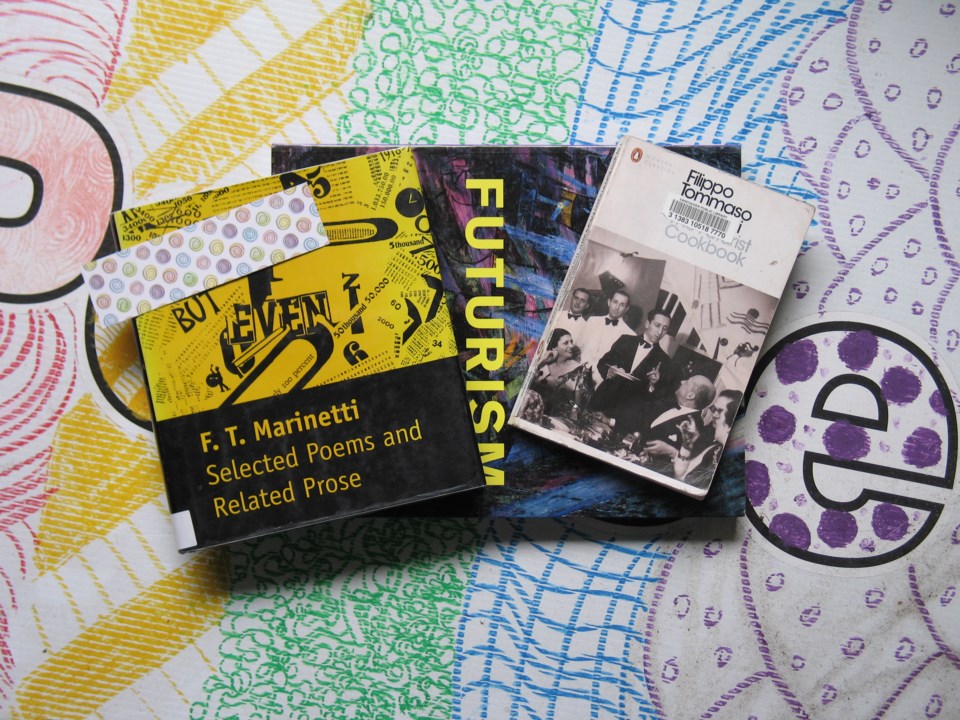Maseratis, Lamborghinis, Bugattis, Ferraris, Alfa Romeos—even Fiats, made in 1899 and the third car in the world after GM’s and Ford’s. All of them from Italy; all of them synonymous with speed and good design.
No wonder Futurism—the art and social movement, not to be confused with futurists, who systematically explore possibilities about the future—also started in Italy, where it largely remained.
Founded in Milan in the early 1900s by the Italian poet Filippo Tommaso Marinetti, Futurismo, as it’s called in Italian, is all wound up in speed, dynamism, technology, and youth. Simply speaking, Marinetti despised everything old, especially politics and traditions in art, and championed anything new that smashed up the past—including violence and war. But he also championed art united with life.
It’s a complicated movement, filled with as many cautions as creativity, but I’ve always been pretty fascinated by Futurism’s art, like Umberto Boccioni’s Unique Forms of Continuity in Space, a famous bronze depicting a figure in motion that looks like early stop-motion photography in 3-D, some kind of chopped modern Mercury with winged feet.
On the other hand, I also have huge problems with some of Futurism, like Marinetti’s misguided notion of “war = revolution” (try telling that to the beleaguered people of Ukraine). Or the way Futurism helped spread fascism. Or its belief that the then-impending First World War was inevitable, and would deliver some kind of fantastical, utopian world order bringing humans and machines closer together to reign over nature. (I wonder what David Suzuki or Geoffrey Hinton, the “Godfather of A.I.” , would say about that.)
Still, the largely overlooked Futurists were pretty fascinating, with their many manifestos and various expressions in dance, painting, theatre, architecture, you name it. So I was excited to see one of Michael Portillo’s Great Continental Railway Journeys on Knowledge Network—the one featuring Italy, from Pisa to Lake Garda—stop at a café in Florence I’d once rambled through and needed a poke to recall.
Now Le Giubbe Rosse Restaurant, it originally opened in 1899—the same year the first Fiat rolled off the assembly line—as the Caffè Letterario Giubbe Rosse, or Giubbe Rosse Literary Café, known for its coffee and the avant-garde conversations stimulated by same along with the collection of newspapers and magazines customers relished, especially travellers and ex-pats from around the world. Eventually, the café became an incubator for all kinds of creative ideas. Something like The Point, Whistler’s dynamic and long-standing artist-run centre located in the old youth hostel on the west side of Alta Lake. (Stand by for their Indigenous Artisan Showcase opening June 23.)
Marinetti and the creative people intrigued by his ideas would meet in Le Giubbe Rosse, where you can still check out the vibe, only the Futurists are now reduced to 2-D images in great swaths of photos hanging all the way up to the ceiling, along with posters, sketches and other intriguing bits from the heyday of Futurism. But one thing that really distinguishes it from other modern art movements were the huge number of manifestos it generated on whatever captured the Futurists’ collective imagination, including cuisine.
Of course! After all, Futurism happened in Italy, and what’s more Italian than really great food?
If you want a taste of some amazing summer reading, you could do a lot worse than Marinetti’s The Futurist Cookbook—just one of his many books and “a powerful offensive against the old way of cooking.” You’ll never think of cookbooks the same way again. (Penguin’s Modern Classics offers a fine inexpensive edition, or there’s a more precious Chronicle Books one, starting at US$100+ for a used copy.)
Part scandalous-for-the-time provocation, part witty joke, part starry-eyed imaginings, The Futurist Cookbook offers all kinds of recipes, and I use the term loosely. There’s the “bachelor dinner” recipe, as “Futurist cooking sets out to avoid the usual pitfalls of eating alone, like the anti-human solitude that fatally drains a part of the stomach’s vital forces.”
In a dining room decorated with Futurist Aeropaintings and aerosculpture, “bachelor dinner” features a table with legs made of accordions topped with food portraits on “jingling plates bordered with bells.” One is Blonde Food Portrait: “a beautiful piece of sculpted roast veal with two long eyes of garlic in a dishevelment of chopped boiled cabbage and small green lettuces. Dangling earrings of little red radishes soaked in honey.” Likely the closest Whistler ever got to something like that were Bearfoot Bistro’s now-defunct, legendary bacchanalian wine raves during Cornucopia.
Then there’s the Dark Man-Friend Food Portrait with its chocolate hair and moustache and “nice necktie of tripe in broth.” Plus the Food Portrait of the Enemies—seven cubes of Cremona nugget with little wells of vinegar and a big bell on one side.
You’ll also learn how to stage an “extremist banquet” which largely centres around electric fans stirring up various “perfumes”—odours from the sea and associated fish markets, smells from a barn and a lake, and more. Or an “economical dinner” like The Total Rustic made from apples cooked in the oven, then stuffed with beans “boiled in a sea of milk.”
More summer reading: If you’re a fan of Michael Portillo’s show, or someone you love is, the contemporary re-issue of Bradshaw’s 1913 Continental Railway Guide he uses in his shows makes a super idea. The bright red cover is a perfect repro of the 1913 edition, and it comes complete with the hotel ads and maps circa 1913, so you can follow along or create your own tour à la Bradshaw’s.
Much cheaper than a new Maserati, which can set you back up to $200,000. Otherwise, AutoTrader lists a second-hand 2014 Lamborghini in Richmond for as little as $159,990.
Me, I’ll stick with my 20-year-old Smart Car and just read the cookbook.
Glenda Bartosh is an award-winning journalist who still hasn’t gotten over missing the Tate Modern’s big Futurist retrospective.




